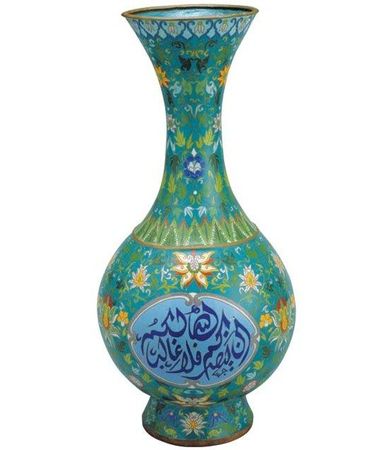"Islamic Arts from Southeast Asia: Highlights of the Asian Civilisations Museum" @ Singapore
Large vase. China, Guangzhou, ca 1900. Gilded brass and enamel
SINGAPORE.- The Asian Civilisations Museum presents highlights of Islamic arts of Southeast Asia from its own collection, including several recent acquisitions, in the exhibition Islamic Arts from Southeast Asia: Highlights of the Asian Civilisations Museum, on display at the museum through 20 January 2013. The exhibition reveals how artistic ideas from central Islamic lands were adapted in Southeast Asia to create a style that is uniquely our own.
A distinctive art
“This exhibition focuses on objects made with a specific religious purpose or design,” says Dr Pedro Moura Carvalho, chief curator of the museum and curator of the exhibition. “In many cases, these objects were commissioned by a Muslim patron for use in a mosque, school, or other religious contexts. And many of the objects are inscribed in Arabic – the language of the Qur’an – or Jawi, the regional script based on Arabic but adapted to reflect the languages of this region.”
The objects show a wide variety of materials and forms. It is especially noteworthy that a strong Southeast Asian identity remains in objects that have parallels throughout the Islamic world. Local traditions of batik, drums, and wooden sculpture were adapted to Islamic objects. Porcelain and enamel with Arabic inscriptions were specially commissioned from factories in China for use in Southeast Asia.
“The Asian Civilisations Museum has one of the most important collections of Islamic Southeast Asian art,” says Alan Chong, director of the museum. “The Islamic Arts Museum Malaysia in Kuala Lumpur also has a significant collection, but this category is underrepresented in Europe and North America. We hope we will make a contribution to understanding this distinctive iteration of Islamic culture. A series of programmes and lectures will explore this field in depth for our audiences.”
Multicultural influences in Singapore
Islam is integral to the culture of Singapore. The surrounding region is home to some of the largest populations of Muslims. Many of the region’s architectural and artistic forms have their origin in Iran, northern India, Turkey, and North Africa.
Mosques are one of the most visible symbols of Islam. In a special section of the exhibition reflecting the diverse cultural roots of Singapore, an array of photographs highlight some of the many architectural styles used to build local mosques. Some follow Malay and Javanese styles, while others show influences from China, the Indian subcontinent, and the Middle East, and occasionally even reflect Western architectural conventions.
The exhibition includes mosque furnishings from the Wak Sumang Mosque in Punggol, now demolished. Displays will enhance visitors’ understanding of the Islamic arts in Singapore.
Dr Moura Carvalho, curator and a leading scholar of Islamic arts, goes on to explain, “The arts produced by Muslims and for Muslim patrons in Southeast Asia are probably the least studied and understood in the Islamic world. We hope that this exhibition will draw more attention to the richness and variety of Southeast Asian Islamic arts and contribute to a better appreciation of such a unique history.”
Historical background
Islamic art is intrinsically linked to one of the world’s major religions. Founded by Prophet Muhammad (died 632) almost 1400 years ago, Islam expanded rapidly through conquest, commercial contacts, and mass conversions. The expansion of Islam in Southeast Asia has yet to be fully understood. By tradition, Sufi mystics are thought to have played a major role in its spread, but trading contacts with China and the Near East must have had a more decisive impact.
Sireh box and cover. Probably Indonesia, Riau-Lingga Archipelago, 19th century. Brass and gold. This betel nut box is decorated with a technique called niello, in which a black sulphur compound is inlaid into the design. The contrasting pattern is created by hammering.
A multicultural sarong. Indonesia, northern Java, early 20th century. Cotton batik.

/https%3A%2F%2Fprofilepics.canalblog.com%2Fprofilepics%2F1%2F0%2F100183.jpg)
/https%3A%2F%2Fstorage.canalblog.com%2F03%2F02%2F119589%2F96711876_o.jpg)
/https%3A%2F%2Fstorage.canalblog.com%2F11%2F31%2F119589%2F94773502_o.jpg)
/https%3A%2F%2Fstorage.canalblog.com%2F20%2F83%2F119589%2F94772815_o.jpg)
/https%3A%2F%2Fstorage.canalblog.com%2F26%2F72%2F119589%2F75604929_o.jpg)
/https%3A%2F%2Fstorage.canalblog.com%2F59%2F60%2F119589%2F26458628_o.jpg)





/http%3A%2F%2Fstorage.canalblog.com%2F00%2F00%2F119589%2F129758935_o.jpg)
/http%3A%2F%2Fstorage.canalblog.com%2F29%2F28%2F119589%2F129637299_o.jpg)
/http%3A%2F%2Fstorage.canalblog.com%2F88%2F37%2F119589%2F129631480_o.jpg)
/http%3A%2F%2Fstorage.canalblog.com%2F77%2F79%2F119589%2F129631259_o.jpg)